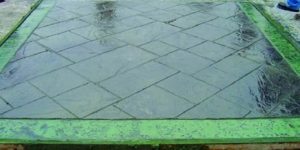Any time you’re dealing with integral color, the key to success is getting a nice, even distribution of pigment. The key to that, in turn, is managing the water-to-cement ratio in your mix.
Keeping that ratio low is very doable with most concrete, but things get a little more complicated when dealing with self-leveling mixes. When adding powdered integral colors to a self-leveling mix, you run the risk of excess pigment floating to the top. The result is a finished product with a higher concentration of pigment at the surface than deeper in the concrete.
Pigment float is an issue you can run into any time you’re using powdered integral colors with concrete, says Ed McLean, sales engineer for CTS Cement Manufacturing Corp., but the risk is much higher with self-leveling concrete because of its fluid consistency. “The pigment particles that don’t get into the solution in a fluid mix tend to float to the top of the surface because there is nothing resisting them,” he says, “whereas in a traditional 4-inch slump portland cement concrete the particles tend to stay where they are in the mix because they have no easy path to get to the surface.”
A vibrantly colored surface may not seem like the end of the world, but the color difference between the surface and the underlying concrete can pose problems not only in the case of damage somewhere down the line, but also just in the process of finishing the slab. Bart Sacco, owner of Concrete Texturing Tool and Supply, a Pennsylvania-based supplier, warns that when gauge-raking a slab suffering from pigment float, you’ll end up with a striped surface, as the tines of the rake will drag lines through the floating pigments. If you’re stuck with pinstriped pour, Sacco recommends using a smoothing tool (of the sort that resembles a giant spackle knife) to even out those stripes of color. If you find yourself in this situation, act fast — as soon as the concrete is down, and you’re done with the gauge rake, it’s time for the smoothing tool. Keeping the blade of the tool at the same angle throughout and using even, unidirectional passes, a contractor can, with some practice, get the surface pigment back to a uniform finish, he says.
But that’s treating the symptoms, not the disease. Unfortunately, there’s no single cure to the pigment-float problem, but there are things you can do to minimize the risk. An easy one is to avoid it altogether by using liquid pigment. Because these pigments are already suspended in a liquid solution, they’re much more likely to stay put in self-leveling mixes.
If you are going to use powdered pigments, says Dave Frasca, a salesman and trainer for Cohills Building Specialties Inc., of Phoenix, Ariz., mix the pigment with the water first, before you add the self-leveling mix to the bucket. The goal is to get the pigment fully suspended in the water — when mixing self-leveling concrete you are adding a lot of water to the mix. Whenever you overwater colored concrete, the pigments can float to the surface and you’ll see ribbons of color.
McLean says there are a number of things to be focused on when mixing your pigments with water. “Each color requires a different amount of water to get the pigment into solution,” he says. So contractors will need to experiment not only with the amount of water, but also the type of mixer paddle and the mixing angle and speed. (Rule of thumb: Contrary to expectation, a slow, even mix is better than fast and aggressive in this case, McLean says.)
Because there’s no way to look at a batch of integral color and tell when it’s fully suspended in the water, the only real way to protect yourself against pigment float is to do some thorough testing and make careful notes of what works and what doesn’t. And remember to do another round of testing any time you change the color you’re using or the self-leveling mix you’re adding it to.
Is there any important difference regarding this issue between using integral color in a self-leveling overlay and integral color in a self-leveling concrete mix that is not an overlay? “There is not much difference,” Sacco says, “except for the pigment dosage rates will change from product to product depending on the amount of cementious content in each.”
Happy mixing!















